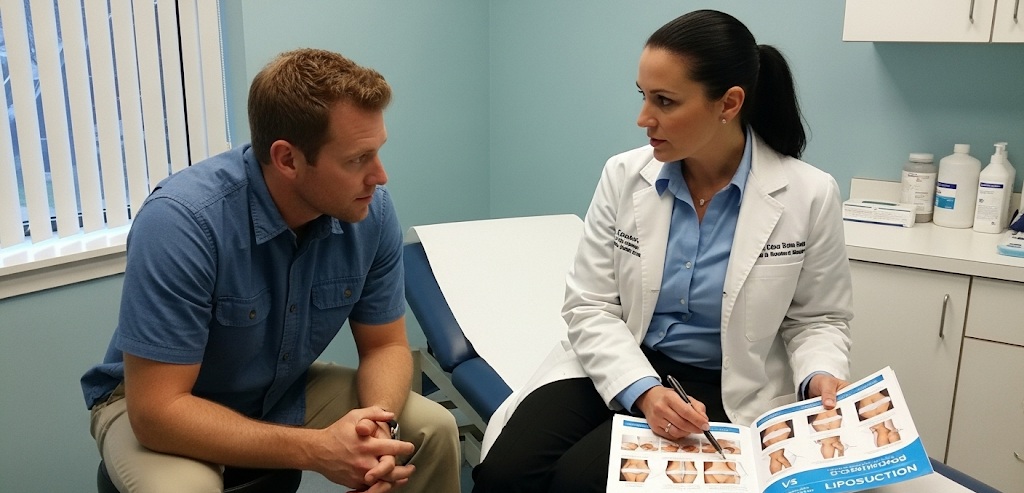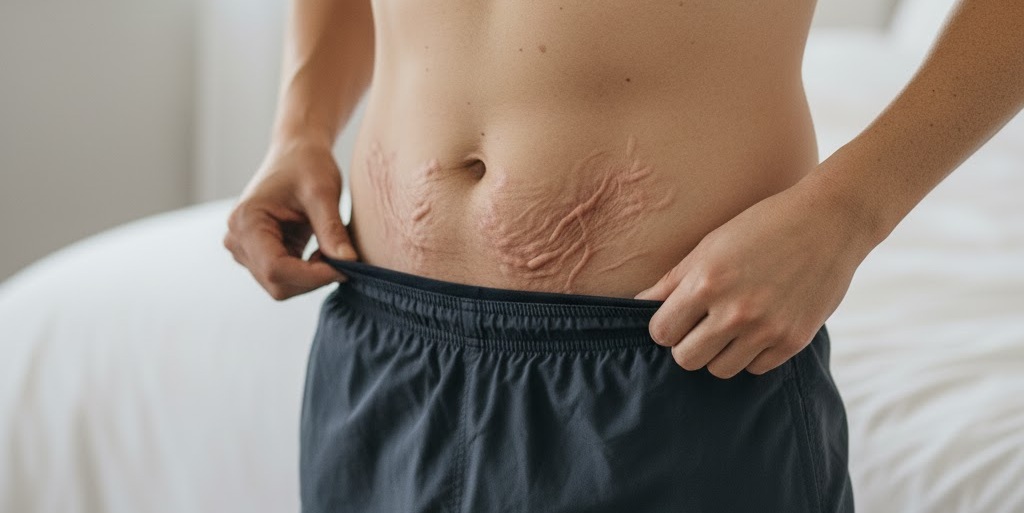Swelling is one of the most common side effects after liposuction. It’s a natural healing response of the body and usually fades within a few weeks. But sometimes, when the swelling lingers and hardens, it can turn into fibrosis after liposuction.
What exactly is fibrosis after lipo? It’s when small areas of scar tissue form beneath the skin, creating a firm or uneven texture. While it’s not directly dangerous, it can affect how your results look and feel, and patients who experience it should definitely get it treated.
Most liposuction fibrosis treatments focus on helping your lymphatic system drain properly and soften the skin. In more advanced cases, you can remove fibrosis with a specialized surgical procedure to restore smoother contours.
In this article, I’ll walk you through what causes post-lipo fibrosis, how to recognize it early, and the most effective ways to treat and prevent it. I’ll also share how my team at True Contour Medical helps patients avoid this issue and how we safely correct it for those who had liposuction done elsewhere.
What Is Fibrosis Lipo?
Fibrosis after liposuction is essentially abnormal scar tissue that forms beneath the skin during liposuction recovery. It often feels like uneven bumps or firm patches, as if parts of that area have become stiff or hard.
In most cases, fibrosis appears as small depressions, soft or hard nodules, adhesions, or encapsulated fluid lumps. These symptoms are caused by an overproduction of collagen combined with poor lymphatic drainage. In simple terms, this means that the body is having problems removing scar tissue and waste from that area.
So what actually causes that circulatory “traffic jam”?
The main cause is lymph fluid getting trapped. This is a clear liquid that carries white blood cells and nutrients to help you heal. When that fluid can’t drain properly, it builds up and triggers inflammation and scar tissue formation. That’s when fibrosis after lipo starts to appear.
After liposuction, how can we tell the difference between fibrosis and normal swelling? Typical post-lipo swelling feels soft and gradually fades over a few weeks. Fibrotic tissue, on the other hand, feels firm or rope-like — sometimes like a bumpy circle under the skin — and doesn’t seem to go away.
Types of Fibrosis After Liposuction
According to the Aesthetic Surgery Journal, there are four grades of liposuction fibrosis:
- Grade I – Depressions: Areas of tissue loss or asymmetry caused by excessive or uneven fat removal.
- Grade II – Nodules: These may be soft (encapsulated fat cells) or hard (solid, non-deformable lesions).
- Grade III – Adhesions: Bands of scar tissue that fuse the superficial and deep layers under the skin.
- Grade IV – Cutaneous Bursas: Fluid-filled capsules within the connective tissue. These are usually the most severe forms.
The type of post-lipo fibrosis depends on how the body heals and what factors influence recovery.
What Causes Fibrosis After Liposuction?
Some causes of fibrosis after lipo are linked to the procedure itself, others to genetics or aftercare.
- Removing too much fat during liposuction, or doing so unevenly. That’s why it’s important to only work with qualified, well-reputed providers.
- Genetic predisposition. Some people naturally form thicker scar tissue. Reviewing the patient’s medical history before liposuction can help us manage this.
- Not following the proper post-op care such as compression garments, massages, or movement. To prevent this, we give detailed steps, as well as follow up sessions for control and care.
At True Contour Medical we always address these causes right from the initial consultation. I spend at least an hour talking with patients about their expectations, medical history, previous procedures, and lifestyle. We also assess BMI and discuss what’s realistically and safely achievable to keep your results smooth and balanced.
Some swelling and hardness are perfectly normal after liposuction, and we always schedule follow up consultations. But if a patient notices the scars are not healing properly, here’s what we tell them to do.
How to Know If You Have Fibrosis After Lipo
There are a few key differences between normal post-lipo swelling and fibrosis after liposuction. Both involve inflammation and fluid buildup, but it’s how that swelling progresses that makes the difference.
If the inflammation doesn’t go away after about four weeks, or if you still feel tenderness and firmness in the area, that could be a sign of post-lipo fibrosis.
Natural swelling after liposuction tends to fade noticeably within the first couple of weeks. You’ll feel softer tissue and see gradual improvement as your body heals.
If these early signs of firmness and discomfort don’t improve over time, that’s when you should check in with your surgeon or a fibrosis treatment specialist.
When patients come to me with these concerns, I usually start by ordering an MRI or ultrasound to get a clear look at what’s happening under the skin. Even though fibrosis often shows as bumpy, hardened skin, imaging helps confirm what’s really going on.
With these studies , we can see how much fibrotic tissue has formed, how it’s structured, and why it’s happening. Then we can decide the most effective and safe treatment plan to fix fibrosis.
Is Fibrosis Dangerous or Just Annoying?
Fibrosis after liposuction isn’t dangerous or directly life-threatening. Still, this doesn’t mean it should be ignored. If left untreated, it can cause long-term inflammation, skin irregularities, and discomfort that become harder to correct over time.
Let’s clear up one of the biggest misconceptions: No, fibrosis doesn’t cause cancer directly.
What sometimes confuses people is that chronic inflammation can increase certain health risks. But that’s not what we’re talking about with post-lipo fibrosis. In these cases, the issue is localized, affecting only the treated area, and it’s very manageable with the right care.
Compared to other forms of fibrosis — such as liver (cirrhosis) or heart fibrosis — liposuction-related fibrosis is far less concerning and much easier to treat.
Treatments for Fibrosis: What Works

We’ve talked about how fibrosis after liposuction happens when lymphatic fluid gets trapped and scar tissue builds up. So to fix it, we need to help your lymphatic system get moving again.
That’s exactly what the following fibrosis treatments help do:
Lymphatic Drainage Massage
After liposuction, I always recommend at least 10 professional lymphatic drainage sessions . If the patient’s budget allows, ideally up to 20 sessions. These specialized massages help prevent fibrosis, reduce swelling, and speed up recovery.
What is a lymphatic drainage massage exactly? It’s a light-pressure technique designed to move trapped lymphatic fluid toward the lymph nodes. Those gentle targeted moves help your body clear waste and heal faster.
A certified lymphatic massage therapist understands where your main lymph nodes are and how to activate them safely. During your session, he or she will guide you through deep breathing and apply soft rhythmic strokes to specific areas that stimulate drainage.
While home massages can help, they’re best used as a complement, not a replacement, for professional practitioners.
Liposuction Fibrosis Self Massages at Home
In addition to your professional sessions, I usually teach my patients simple, at-home techniques for lipo recovery. You’ll need just a few tools:
- For smaller areas like arms, legs, or under the chin, use a spiky massage ball.
- For larger zones like the abdomen or flanks, a fascia roller works well.
To do effective self-massages, just lie in a comfortable position where you can easily reach the area. Roll the ball or fascia tool over the firm spots using light, slow pressure. Just don’t over-press.
Most patients can begin self-massage about two weeks after surgery, but always wait for the surgeon to give the green light, just in case.
Ultrasound Therapy
Moving on to more specialized after care, we have ultrasound therapy, a powerful, non-surgical way to treat liposuction fibrosis. It uses sound waves to gently vibrate and loosen hardened tissue, improving circulation and lymphatic drainage deep within the area.
At True Contour Medical, we usually recommend around four ultrasound sessions, but the exact number depends on the severity of the fibrosis.
Surgery To Correct Fibrosis Liposuction
What if none of these methods are enough? Good news is that fibrosis can still be surgically corrected. This is typically reserved for severe cases, where patients had their procedure done with a different provider and didn’t receive proper aftercare.
This corrective procedure may involve a combination of fat grafting, direct fibrosis removal, and skin tightening. In simple terms, we remove the hardened tissue, even out the surface, and recontour the area for smoother, more natural results.
How to Prevent Fibrosis After Lipo
As we said, preventing fibrosis after liposuction is a team effort: part in the surgeon’s hands, part in yours.
On our end, the goal is to perform the procedure with as little trauma as possible. That means planning carefully before we even step into the OR. I take time to make precise markings, evaluate your fat distribution, and map out how to sculpt evenly while protecting your skin and tissues.
At True Contour Medical, we use advanced liposuction technologies like PAL (Power-Assisted Lipo) and VASER Lipo, which allow for more precision and less tissue damage. These tools help reduce post-operative swelling and lower the risk of fibrosis from the start.
But after that, it’s your turn. Preventing post-lipo fibrosis also depends on how well you follow your aftercare plan.
- Wear Your Garments: We always prescribe medical-grade compression garments custom-fit for your body. They apply the right amount of pressure to help drain fluid, support your new shape, and prevent irregularities while you heal.
- Smooth, active recovery stretches: Movement is key for keeping your lymphatic system working properly. Rest is important at first, but as your body recovers, gradually reintroduce light activity. Gentle walking and low-intensity movement improve circulation and help your system flush out trapped fluid.
- Healthy Diet: Your body needs the right nutrients to heal. Avoid alcohol, processed sugars, and heavy, fatty foods during recovery. Stick with balanced, nutrient-rich foods, as we recommend in our diet for liposuction post-op.
Why True Contour Medical Works
When patients come to me worried about fibrosis after liposuction, I often tell them about this case we had. A 74-year-old woman was referred to me for lipedema treatment. She wasn’t very hopeful at first, as her legs were swollen, the skin was uneven. Even walking was painful for her.
Before we did anything, we sat down and talked. I explained the procedure, how we’d help her heal. Just a week after her treatment, she was already moving better and feeling lighter, as you can see in her before and after photos.
Her skin looked healthier, and we kept her recovery on track through follow-ups and a planned second procedure.
That’s what makes us different here at True Contour. We treat all kinds of bodies and goals, but our approach always stays the same: precise work, close follow-up, and every effort to safely manage side effects like fibrosis.
We’ve performed more than 2,000 successful liposuction procedures, all with customized care and recovery plans. We always assess each patient’s case, how much fat we can safely remove, and plan ahead to leave the skin smooth and even.
That’s why so many of our patients trust us, and they come back when they want to take the next step in their body-sculpting journey.
Take the Next Step: Smooth Your Recovery
If you’re dealing with fibrosis after liposuction or need help improving results from another clinic, we can help. Book a consultation at with us, and let’s start creating the body you want within the body you have.
